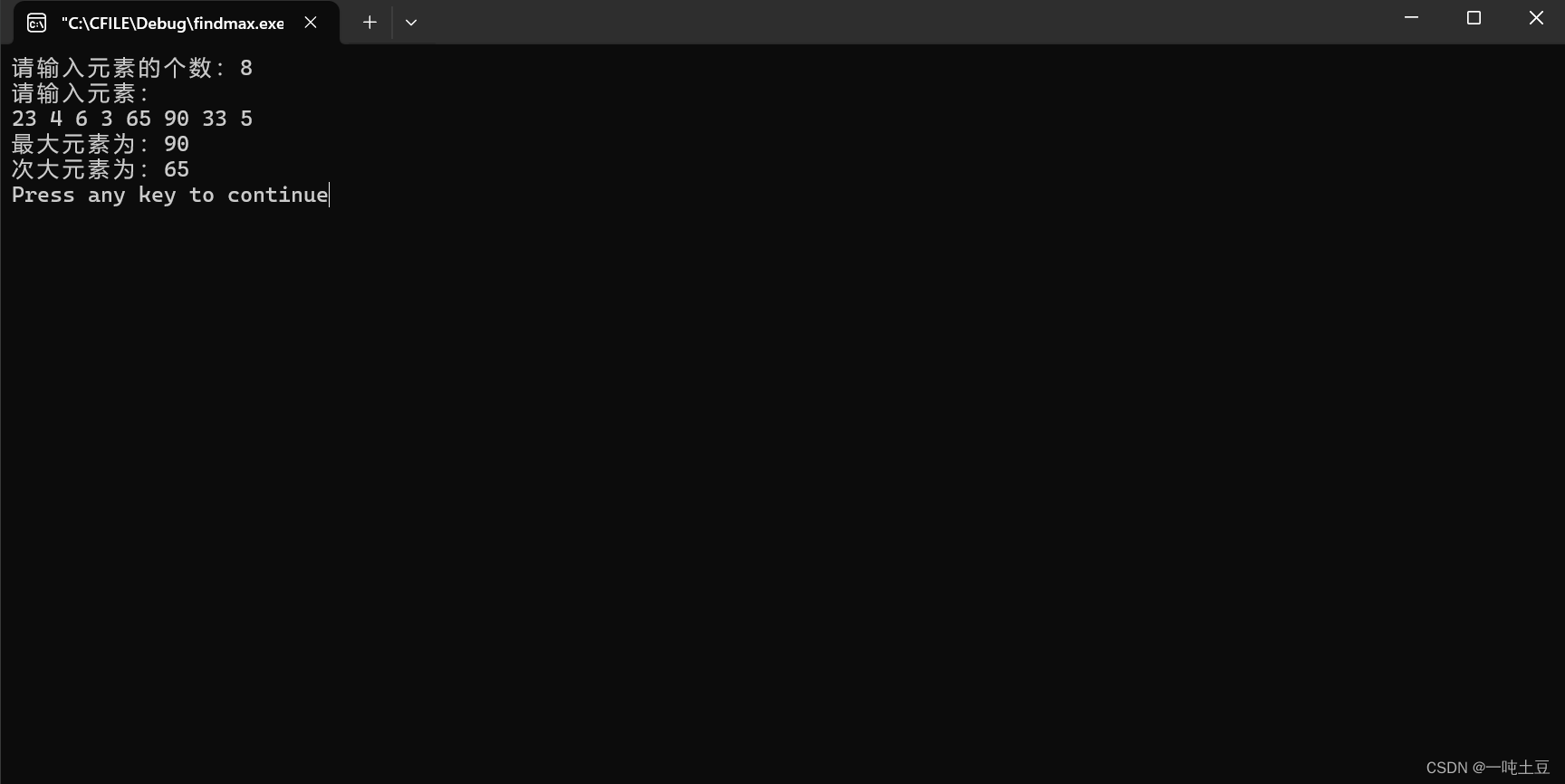1. LMDeploy基本介绍
LMDeploy提供一站式的大模型压缩、部署和服务,其主要特点包括:
- 高效的推理速度。通过引入持久批处理(即连续批处理)、阻塞 KV 缓存、动态拆分与融合、张量并行、高性能 CUDA 内核等关键特性,提供了比 vLLM 高1.8倍的请求吞吐量;
(注:vLLM是一款开源的被广泛使用的大模型推理库,其支持大量的Hugging Face模型, LMDeploy广泛将vLLM作为对比对象) - 高效的量化策略。LMDeploy支持权重和KV量化,INT4量化的推理速度是FP16的2.4被。量化效果已经得到了OpenCompass评估的验证。
- 方便的分布式部署。利用请求分发服务,LMDeploy 实现了跨多机和多卡的多模型服务的方便部署。
- 交互式推理模式。通过在多轮对话过程中缓存注意力的k/v,从而记住对话历史,避免历史会话的重复处理。
LMDeploy在A100卡上与vLLM的全面对比图如下:

目前LMDeploy支持的模型见下图,基本涵盖了主流的开源大模型:
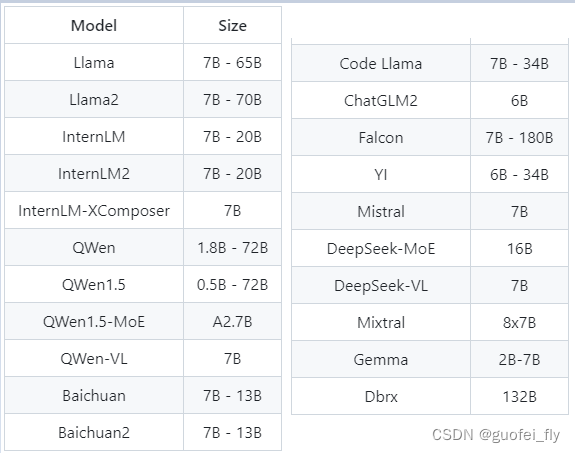
2. 作业实践
2.1 环境配置
安装lmdeploy:pip install lmdeploy[all]==0.3.0

2.2 模型下载
测试模型为InternLM2-Chat-1.8B,利用git-lfs从OpenXLab平台进行下载:
step 1: 安装git-lfs组件
curl -s https://packagecloud.io/install/repositories/github/git-lfs/script.deb.sh | bash
apt update
apt install git-lfs
git lfs install --system
step 2: 下载InternLM2-Chat-1.8B模型:
git clone https://code.openxlab.org.cn/OpenLMLab/internlm2-chat-1.8b.git

2.3 定量速度测试
简单对比下transformers和lmdeploy的推理速度。
采用原生transformers进行Internlm2-chat-1.8b的推理:
import torch
import datetime
from transformers import AutoTokenizer, AutoModelForCausalLM
tokenizer = AutoTokenizer.from_pretrained("/root/internlm2-chat-1_8b", trust_remote_code=True)
# Set `torch_dtype=torch.float16` to load model in float16, otherwise it will be loaded as float32 and cause OOM Error.
model = AutoModelForCausalLM.from_pretrained("/root/internlm2-chat-1_8b", torch_dtype=torch.float16, trust_remote_code=True).cuda()
model = model.eval()
# warmup
inp = "hello"
for i in range(5):
print("Warm up...[{}/5]".format(i+1))
response, history = model.chat(tokenizer, inp, history=[])
# test speed
inp = "请创作一首五言绝句。"
times = 10
total_words = 0
start_time = datetime.datetime.now()
for i in range(times):
response, history = model.chat(tokenizer, inp, history=history)
total_words += len(response)
end_time = datetime.datetime.now()
delta_time = end_time - start_time
delta_time = delta_time.seconds + delta_time.microseconds / 1000000.0
speed = total_words / delta_time
print("Speed: {:.3f} words/s".format(speed))
整个的推理速度为Speed: 41.292 words/s(与token正向线性相关)
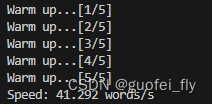
采用lmdeploy进行推理:
import datetime
from lmdeploy import pipeline
pipe = pipeline('/root/internlm2-chat-1_8b')
# warmup
inp = "hello"
for i in range(5):
print("Warm up...[{}/5]".format(i+1))
response = pipe([inp])
# test speed
inp = "请创作一首五言绝句。"
times = 10
total_words = 0
start_time = datetime.datetime.now()
for i in range(times):
response = pipe([inp])
total_words += len(response[0].text)
end_time = datetime.datetime.now()
delta_time = end_time - start_time
delta_time = delta_time.seconds + delta_time.microseconds / 1000000.0
speed = total_words / delta_time
print("Speed: {:.3f} words/s".format(speed))
整个的推理速度为Speed: 41.292 words/s(与token正向线性相关)
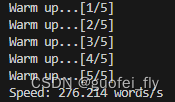
可见,测试样例上lmdeploy的推理速度为原生transformers的6倍。
2.4 设置KV Cache和W4A16量化
常见的 LLM 模型由于 Decoder Only 架构的特性,实际推理时大多数的时间都消耗在了逐 Token 生成阶段(Decoding 阶段),是典型的访存密集型场景。可通过缓存机制、量化算法等方法来优化LLM推理过程。
2.4.1 KV Cache基本概念
KV Cache是一种常用的大模型推理性能优化技术,其可以在不影响任何精度的前提下,通过时间换空间的思想,提升推理性能。
LLM作为生成式模型,其推理阶段是逐个token输出的,next token的推理会用到前面输出token和输入token的拼接,如何不断反复直到遇到终止符,其基本代码如下:
i = 0
with torch.no_grad():
while out_token != token_eos: # 根据词表定义的token_eos
logits, _ = model(in_tokens) # 前向推理
out_token = torch.argmax(logits[-1, :], dim=0, keepdim=True) # 贪婪解码
in_tokens = torch.cat((in_tokens, out_token), 0) # 输入拼接
text = tokenizer.decode(in_tokens) # 用作打印
print(f'step {i} input: {text}', flush=True)
i += 1
其输出效果类似于:
step 0 input: Lionel Messi is a player
step 1 input: Lionel Messi is a player who
step 2 input: Lionel Messi is a player who has
step 3 input: Lionel Messi is a player who has been
step 4 input: Lionel Messi is a player who has been a
step 5 input: Lionel Messi is a player who has been a key
step 6 input: Lionel Messi is a player who has been a key part
step 7 input: Lionel Messi is a player who has been a key part of
step 8 input: Lionel Messi is a player who has been a key part of the
step 9 input: Lionel Messi is a player who has been a key part of the team
step 10 input: Lionel Messi is a player who has been a key part of the team's
step 11 input: Lionel Messi is a player who has been a key part of the team's success
step 12 input: Lionel Messi is a player who has been a key part of the team's success.
这也就是为什么我们看到的绝大部分LLM应用采用流式输出的原因。
不难发现,随着拼接token的长度变长,推理过程的FLOPs会随之增大。另一方面,后面每个token的推理均用到了前面所有输出token的k-v值,其存在着重复计算的浪费。如果能够将前面输出token的k-v值缓存起来,那可以大大提升推理效率。如在transformers库中设置past_key_values参数,即可实现KV缓存的效果。当然其内部实现逻辑也是concat,不过是原KV缓存和新tokenKV值的concat。
with torch.no_grad():
while out_token != token_eos:
logits, kvcache = model(in_tokens, past_key_values=kvcache) # 增加了一个 past_key_values 的参数
out_token = torch.argmax(logits[-1, :], dim=0, keepdim=True)
in_tokens = out_token # 输出 token 直接作为下一轮的输入,不再拼接
text = tokenizer.decode(in_tokens)
print(f'step {i} input: {text}', flush=True)
采用KV Cache的方法,模型推理中的现存消耗主要可以分为三个部分:
2.4.2 W4A16量化基本概念
模型量化是一种重要的减小模型大小、提升模型推理效率的手段,其将神经网络的浮点计算转换为定点计算,从而将连续的无限值映射到一组较小的离散有限值。模型参数本身占用的显存、KV Cache占用的显存,以及中间运算结果占用的显存。
神经网络模型常见的权重数据格式有FP32(32位浮点,单精度)、FP16(半精度浮点)、INT8(8位整型)和INT4(4位整型)。如采用INT8格式,其相较于FP32可减小75%的模型大小。
按照量化阶段的不同,模型量化又可分为:训练时量化(quantization aware training, QAT)和训练后量化(post-training quantization, PTQ),QAT需要在训练阶段就对量化误差进行建模,一般能够获得较低的精度损失。PTQ 直接对普通训练后的模型进行量化,过程简单。
对于大模型而言,常见量化有两种设置:
1)W8A8 量化,即权重和激活都量化为 INT8;
2)W4A16量化,即权重量化为INT4,激活量化为FLOAT16.
适用于大模型的一些常见量化技术有:
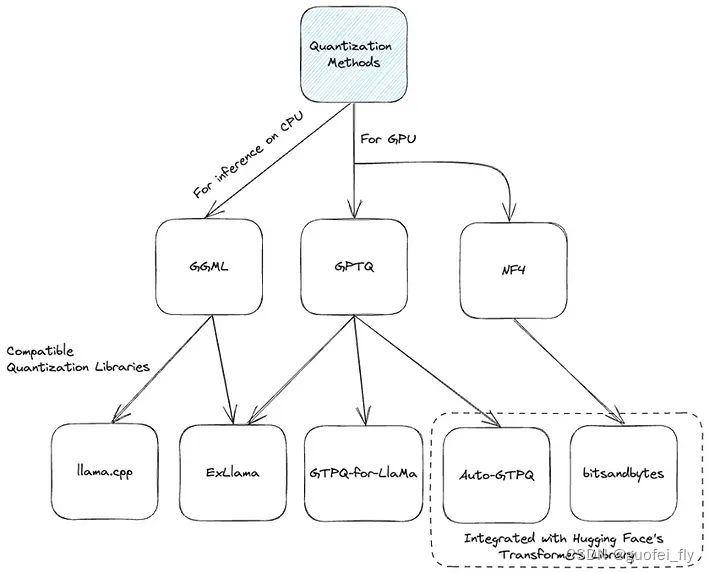
以Qwen-7B-Chat为例,给出了量化后的效果对比。可见合理的采用量化技术,可以明显减小缓存、有效提升推理速度,同时保证模型的精度没有明显的损失。
- 模型评估效果

-
推理速度

-
显存使用

2.4.3 LMDeploy的设置
- KV Cache
LMDeploy的KV Cache管理器可以通过设置--cache-max-entry-count参数,控制KV缓存占用剩余显存的最大比例。默认的比例为0.8。
lmdeploy chat /root/internlm2-chat-1_8b --cache-max-entry-count 0.8
仍以internlm2-chat-1_8b模型为例进行试验,通过设置--cache-max-entry-count为不同值,可得到以下的表格:
| cache-max-entry-count值 | 模型显存大小(MiB) |
|---|---|
| 0.8(默认值) | 20936 |
| 0.5 | 14792 |
| 0.1 | 6600 |
| 0.01 | 4712 |
随着参数值的减小,能感受到明显推理速度的减小。
- W4A16量化
LMDeploy使用AWQ算法,实现模型4bit权重量化,同时推理引擎TurboMind提供了非常高效的4bit推理cuda kernel。
直接利用如下的命令下完成4bit的量化工作:
lmdeploy lite auto_awq \
/root/internlm2-chat-1_8b \
--calib-dataset 'ptb' \
--calib-samples 128 \
--calib-seqlen 1024 \
--w-bits 4 \
--w-group-size 128 \
--work-dir /root/internlm2-chat-1_8b-4bit
同样设置--cache-max-entry-count为不同值,观察模型占用现存的情况:
| cache-max-entry-count值 | bit4量化后模型显存大小(MiB) |
|---|---|
| 0.8(默认值) | 20516 |
| 0.5 | 13732 |
| 0.1 | 4708 |
| 0.01 | 2628 |
可见,通过量化手段可以有效减小模型的显存占用率,当然代价是会损失一定的推理精度。
2.4.4 KV Cache+W4A16量化 模型推理
下图为设置KV Cache最大占用比例为0.4,开启W4A16量化后,以命令行方式与模型对话:
lmdeploy chat /root/internlm2-chat-1_8b-4bit --model-format awq --cache-max-entry-count 0.4

2.5 API Server方式启动 lmdeploy
将大模型封装为API接口服务,可以更方便地让客户端用户进行调用,其电箱的服务流程结构图包括三个模块:
1)模型推理/服务。主要提供模型本身的推理,一般来说可以和具体业务解耦,专注模型推理本身性能的优化。可以以模块、API等多种方式提供。
2)API Server。中间协议层,把后端推理/服务通过HTTP,gRPC或其他形式的接口,供前端调用。
3)Client。可以理解为前端,与用户交互的地方。通过通过网页端/命令行去调用API接口,获取模型推理/服务。
上述三个模块组成的架构图如下:
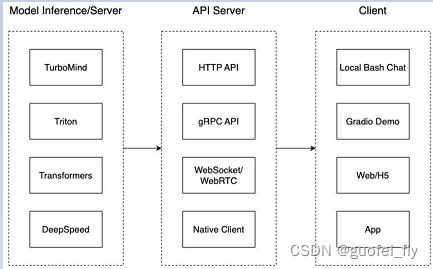
2.5.1 启动后端
启动 lmdeploy后端,开启 W4A16量化,调整KV Cache的占用比例为0.4:
lmdeploy serve api_server \
/root/internlm2-chat-1_8b-4bit \
--model-format awq \
--quant-policy 1 \
--cache-max-entry-count 0.4 \
--server-name 0.0.0.0 \
--server-port 23333 \
--tp 1
其背后使用FastAPI作为server,提供如下的接口功能:

2.5.2 命令行交互
命令行启动客户端:
lmdeploy serve api_client http://localhost:23333
运行后,可以通过命令行窗口直接与模型对话:
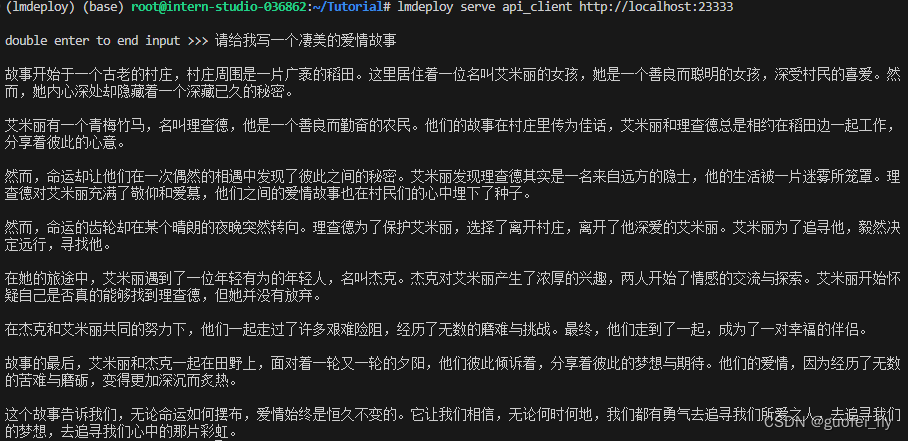
2.5.3 gradio客户端
使用gradio作为client,启动网页客户端并作简单测试:
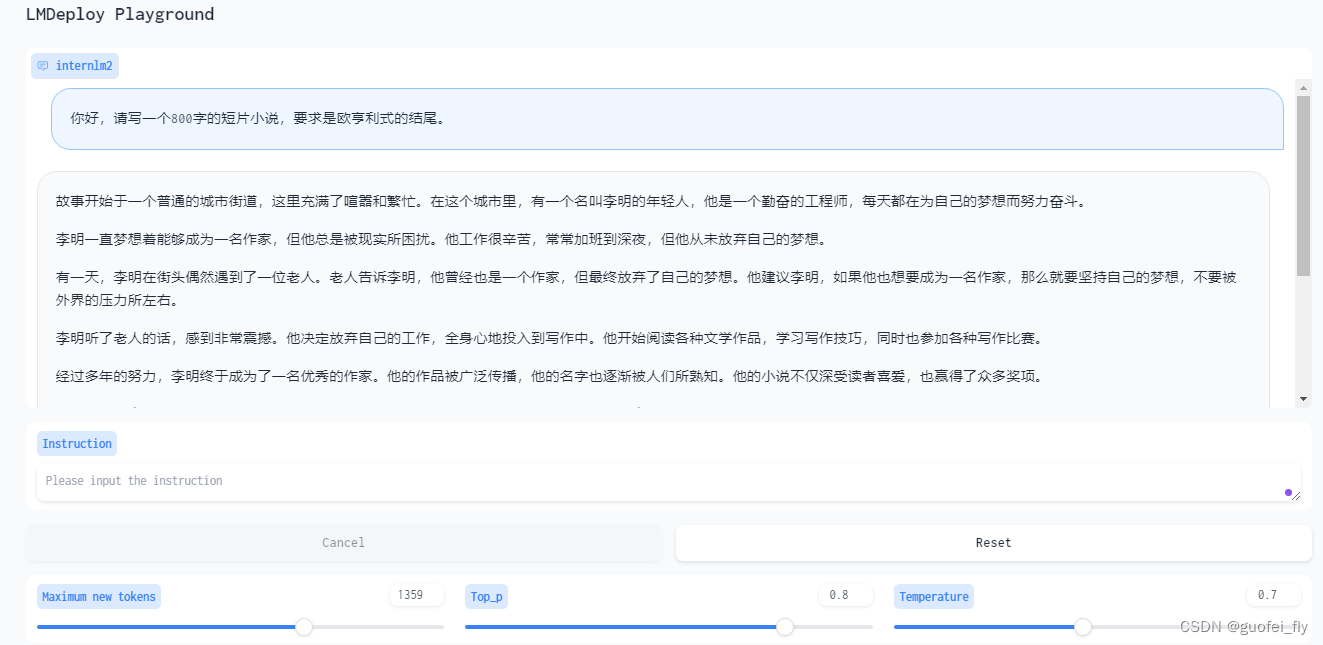
2.6 使用Python代码集成的方式运行LMDeploy
lmdeploy效仿transformers库,提供了pipeline的端到端调用:
from lmdeploy import pipeline
pipe = pipeline('/root/internlm2-chat-1_8b')
response = pipe(['你好,请给我作一首诗', '离离原上草'])
print(response)
返回结果:

小模型的语义理解能力确实还是略显弱小,并没有正确理解本人的意图做出合理的回答。
在python代码中,同样可以设置KV Cache等参数。下面的示例使用W4A16量化,调整KV Cache的占用比例为0.4:
from lmdeploy import pipeline, TurbomindEngineConfig
# 调低 k/v cache内存占比调整为总显存的 40%
backend_config = TurbomindEngineConfig(cache_max_entry_count=0.4)
# 使用W4A16量化
pipe = pipeline('/root/internlm2-chat-1_8b-4bit',
backend_config=backend_config)
response = pipe(['你好,请给我作一首诗', '离离原上草'])
print(response)
返回结果:

模型存在明显的幻觉现象,《离离原上草》是草根歌手周杰伦的代表作了。。。。
2.7 使用 LMDeploy 运行视觉多模态大模型
最新版本的LMDeploy支持了llava多模态模型,这里以llava-v1.6-7b进行推理:
import gradio as gr
from lmdeploy import pipeline, TurbomindEngineConfig
backend_config = TurbomindEngineConfig(session_len=8192) # 图片分辨率较高时请调高session_len
# pipe = pipeline('liuhaotian/llava-v1.6-vicuna-7b', backend_config=backend_config) 非开发机运行此命令
pipe = pipeline('/share/new_models/liuhaotian/llava-v1.6-vicuna-7b', backend_config=backend_config)
def model(image, text):
if image is None:
return [(text, "请上传一张图片。")]
else:
response = pipe((text, image)).text
return [(text, response)]
demo = gr.Interface(fn=model, inputs=[gr.Image(type="pil"), gr.Textbox()], outputs=gr.Chatbot())
demo.launch()
上传了一张本人制作的流程图,这个居然也能回答的七七八八,确实很强大!
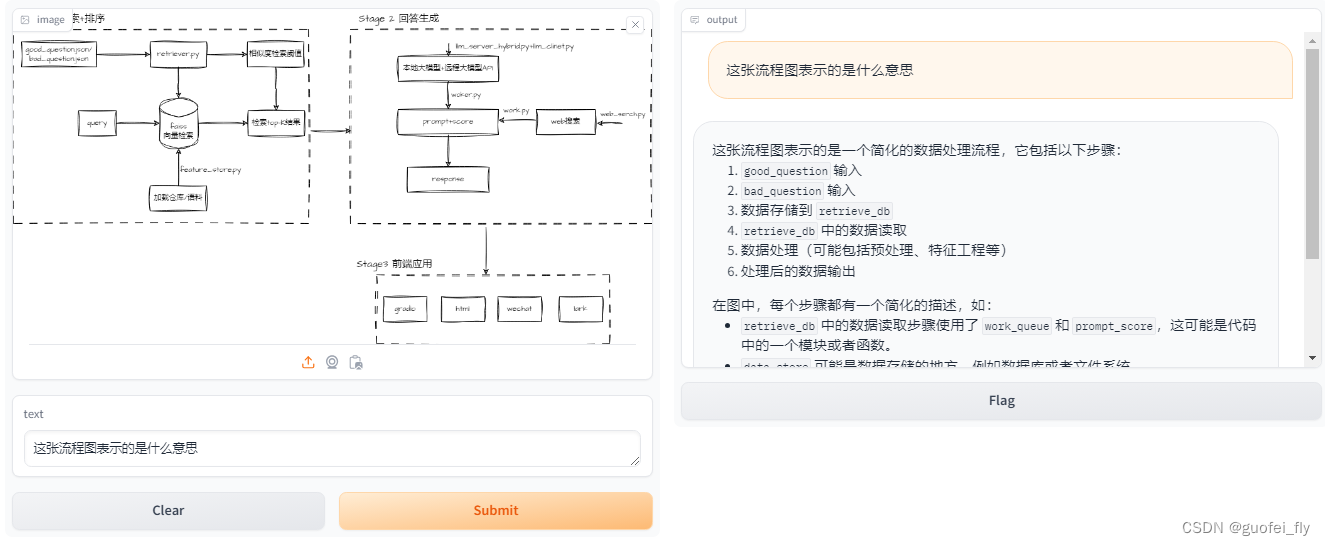
3. 参考资料
- https://github.com/InternLM/Tutorial/tree/camp2/lmdeploy
- https://docs.vllm.ai/en/latest/index.html
- https://github.com/InternLM/lmdeploy
- https://zhuanlan.zhihu.com/p/630832593
- https://zhuanlan.zhihu.com/p/671007819


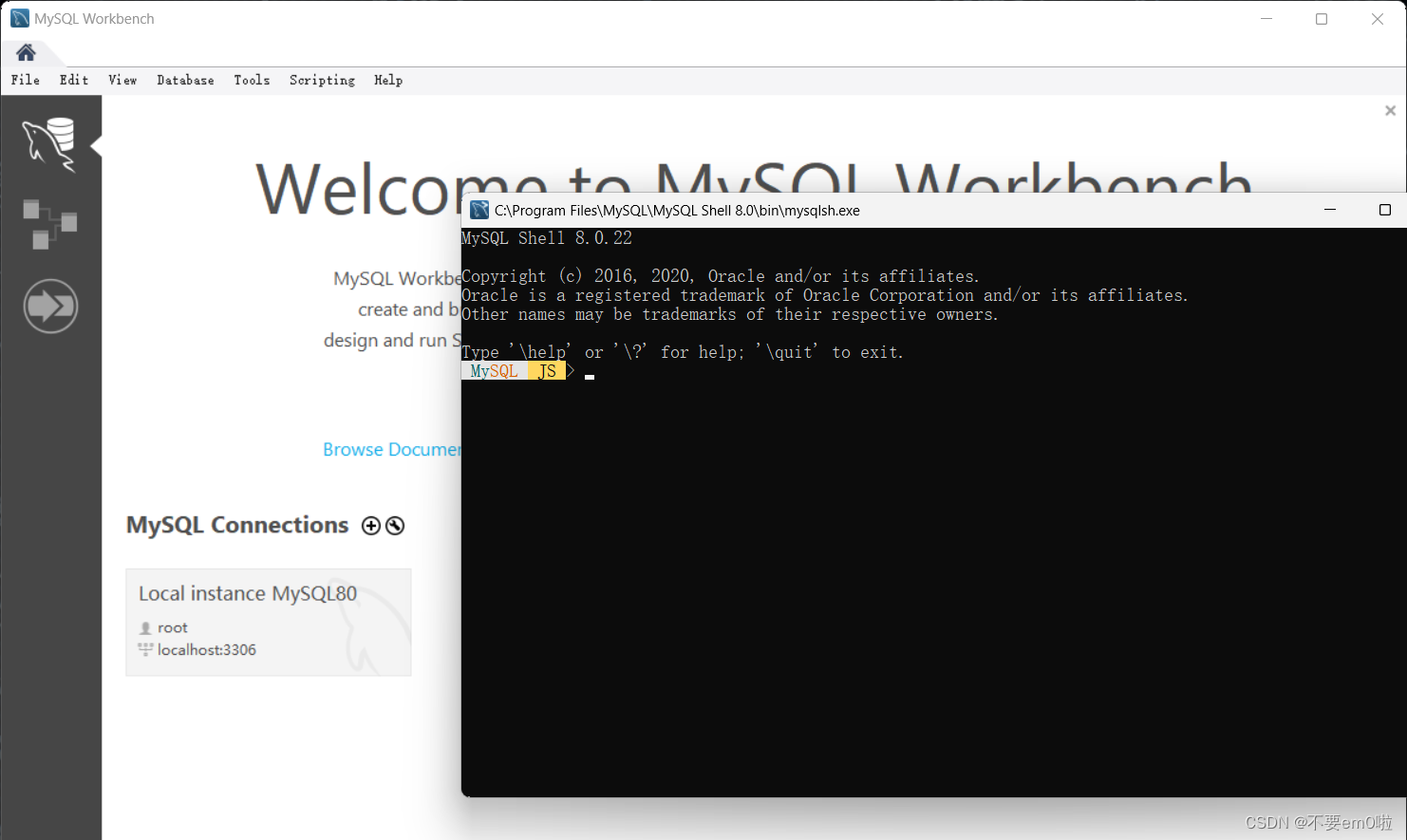
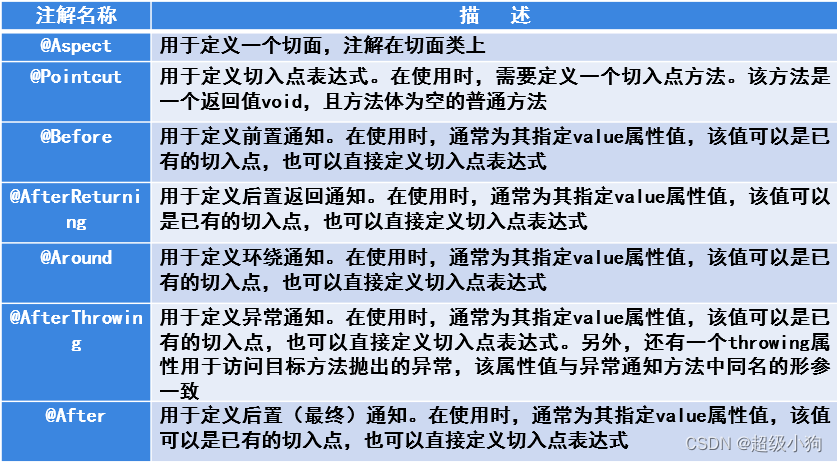
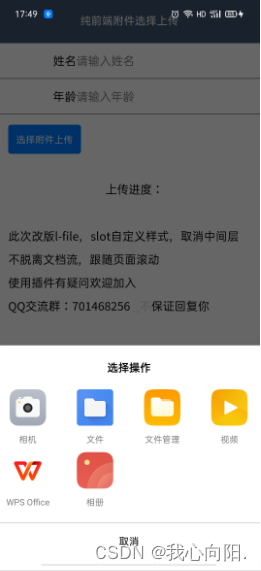
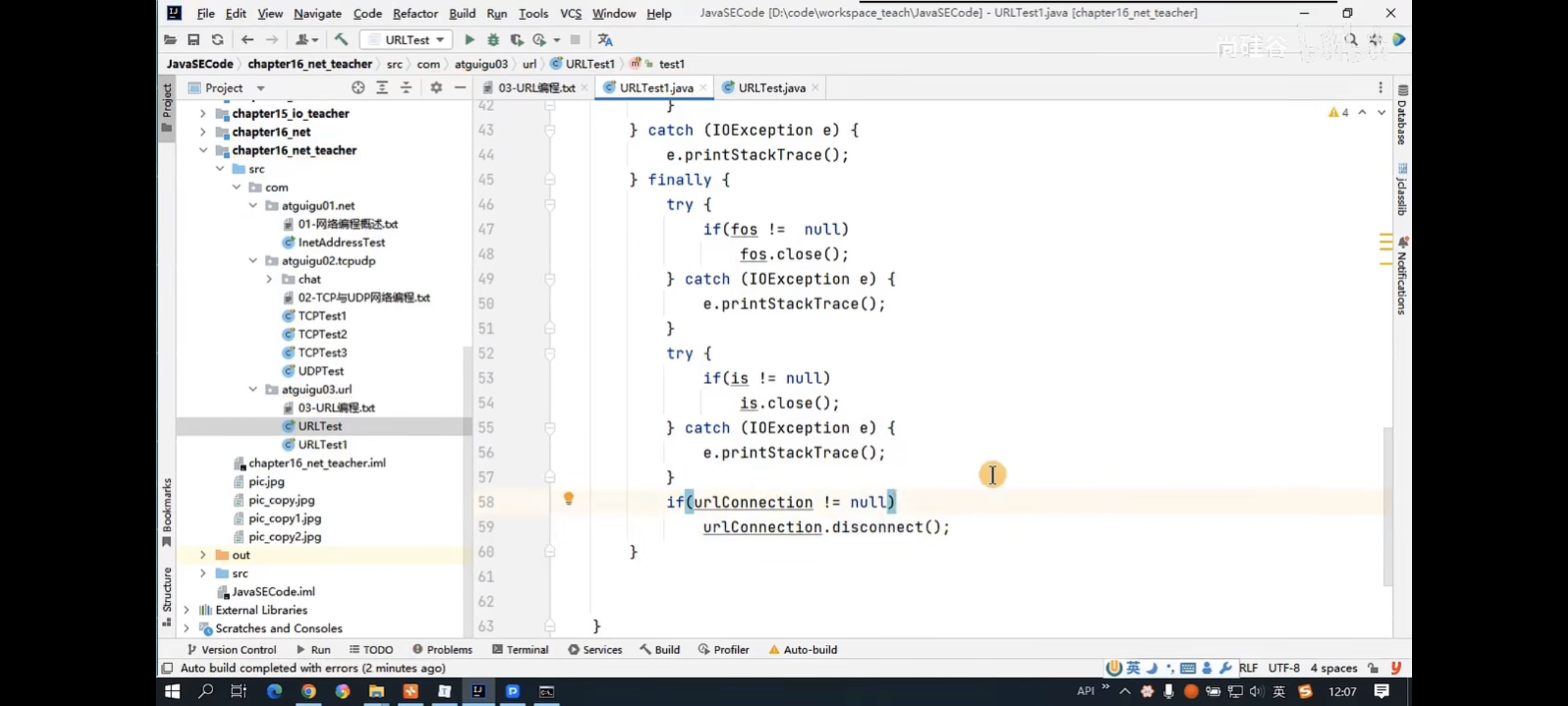
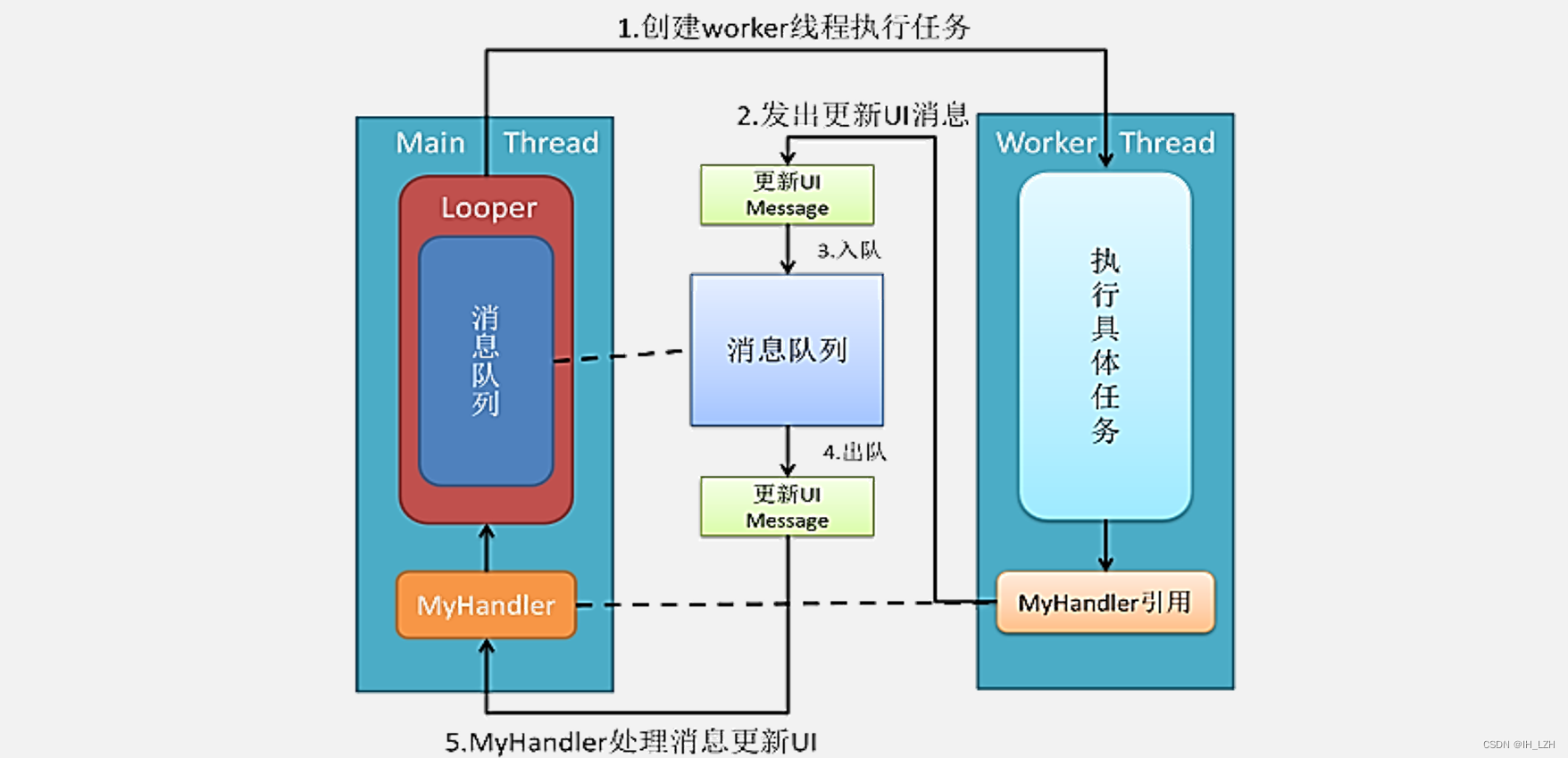


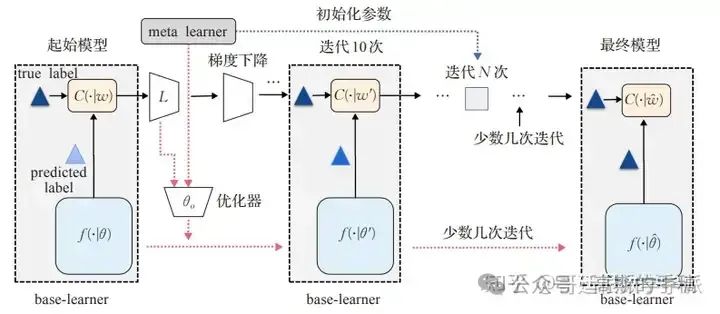




![NL2SQL进阶系列(4):ConvAI、DIN-SQL、C3-浙大、DAIL-SQL-阿里等16个业界开源应用实践详解[Text2SQL]](https://img-blog.csdnimg.cn/img_convert/c755bc6fa0a346df73f0c8898900dec2.jpeg)

